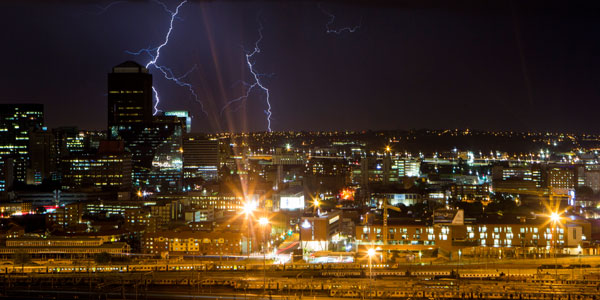Finding facts in a lightning bolt
- Shaun Smillie and Schalk Mouton
Lightning research will answer several questions about this lesser-known force of nature.

A sudden death out in the veld might have gone unnoticed by science if it hadn’t been for the witnesses who saw it happen.
What they saw was a giraffe struck by lightning. And not long afterwards that giraffe’s skeleton ended up at Wits University, and it was here that a group of scientists got an idea.?
The unfortunate giraffe
Through the use of a high powered microscope, the research team that included Dr Hugh Hunt, Senior Lecturer and Head of the Johannesburg Lightning Research Laboratory (JLRL) in the School of Electrical and Information Engineering, and Dr Patrick Randolph-Quinney, a biological and forensic anthropologist at the Centre for the Exploration of the Deep Human Journey, both at Wits University, were able to spot a unique micro-fracturing pattern within the bone, which appeared to be caused by the passage of a lightning current.
Pigs, people and patterns
The researchers then wanted to see if they could replicate the patterning through lab-simulated lightning strikes.
Pig bones were taken to Wits’ lightning lab and struck with artificially created lightning bolts. Then, the test had to be replicated on human bones, but because human cadavers could not be transported to the JLRL, the researchers had to take the lightning to the ??anatomy lab at Wits.
High impulse currents of up to 10 000 amps were shot through the human skeletons and the same tell-tale micro patterning appeared that had first been observed on the giraffe. This research was published in the journal Forensic Science International.
Those unique marks left on bones by lightning could be a big help to pathologists in future. Often lightning strikes leave classic ‘whodunnit’ cases, where a body is found in an open field with no apparent cause of death.
In South Africa it is not even known how many people actually die because of a lightning strike, although the estimates lie between 100 and 140 people per year. Farmers face a similar conundrum when livestock are found dead with no apparent cause of death. Dr Hugh Hunt, Head of the JLRL and co-author of the article, believes their research could also help in challenging dubious livestock insurance claims.
Flash-in-the pan myths
Studying fatal lightning strikes is just part of the research in which the JLRL has been involved – there are myths to be debunked too. For example, the myth that claims that if we could capture a lightning bolt, it would power a city for a year. Regrettably, lightning doesn’t work like that.
“You really can’t [power a city], it’s not enough energy. Even if you take the majority of the electrical energy in the world’s entire atmosphere, it just doesn’t come close to what we use to run cities and industry,” says Hunt, adding that a lightning strike is more like a bomb going off.
Research at the JLRI focuses more on saving property and lives through a better understanding of lightning.
Hunt says, “We don’t know enough about how exactly to predict where lightning is going to strike. We know that if you have a thatch house, we put up a big, tall, metal rod next to it, and that is more likely to be struck than your thatch house. But that’s still quite a rough model. For instance, we don’t know whether it is better to use a copper rod, or an aluminium rod.”
The JLRL’s work will become increasingly important as climate change could cause more lightning strikes in the decades to come.?“There is a fair bit of evidence to show that things are definitely changing. It does generally look like lightning activity is increasing, but is it increasing with the same sort of intensity? With the same amount of current?” asks Hunt.
Bolts from the blue in Brixton
To answer some of these questions, Hunt and his team ??have turned the 237m high Sentech Tower in Brixton, Johannesburg, into a laboratory. The tower receives at least 40 to 50 lightning strikes per year. With an average of 15 lightning strikes per square kilometre per year, ?Johannesburg is one of the most lightning-struck built-up environments on Earth, and thus regarded as the perfect place to study lightning.
Hunt’s team has kitted out the Sentech Tower (also known as the Brixton Tower) with a DEHNdetect, a device used to measure lightning currents. What they learn could one day protect other tall structures, such as wind turbines.
“This is where we get into the physics of what is happening in a single lightning strike and get back to our intention to better protect people and assets,” concludes Hunt.
- Shaun Smillie is a freelance writer.
- Schalk Mouton is Senior Communications Officer for Wits University
- This article first appeared in?Curiosity, a research magazine produced by?Wits Communications?and the Office of the Deputy Vice-Chancellor:?Research and Innovation.
- Read more in the 15th issue, themed: #Energy. We explore energy research into finding solutions for SA's energy crisis, illuminate energy needs of people with disabilities, address the energy and digital divide in an unequal society, and investigate the origins of fire control
